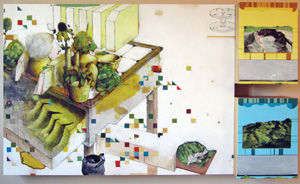From These Hills
Contemporary Art in the Southern Appalachians
By Paige Campbell
Through Feb. 19, the William King Museum and Center for Cultural Art and Heritage in Abingdon, Va., will host the tenth exhibition of From These Hills: Contemporary Art in the Southern Appalachian Highlands, its biennial selection of new works by regional artists.
Guest juror Amy Moorefield, director of Hollins University’s Eleanor D. Wilson Museum, chose 38 pieces from 23 artists for this year’s collection. Paintings, textiles, photographs, and pencil drawings are represented, as well as more unusual works: moving mechanical sculptures, an interactive digital exhibit, manipulated shoes, stuffed animals and beeswax-based portraits.

The biennial "From These Hills" exhibit highlights forward-thinking artists from across Appalachia. (above) "Part of the Field," Issac Powell. Photos by Paige Campbell
Moorefield praises the sophistication of each contributing artist. “What this collection celebrates is the artists’ ability to look globally from within a tradition-rich region to make really relevant work,” she says.
While Moorefield did not set out to reflect a particular theme, she is mindful of what she calls “strong undercurrents at play.” Those undercurrents, include “entropy in nature, the interplay of emotion and desire, systems, the ‘ready-made,’ the idea of ‘other,’ and narrative figuration.”
Multi-media artist Travis Graves of Elizabethton, Tenn., contributed two works, both depicting trees but using different materials to create dramatically altered forms. The variety within his own body of work echoes a larger curatorial shift that he says has taken place in the last several decades.
“There’s a growing recognition of the validity of many art forms as art in their own right,” says Graves. That recognition, he says, has opened the door for this region’s art to take so many shapes.
Drawing Inspiration from Nature, Human Nature
Jake Ingram of Johnson City, Tenn., is just 21 years old, but his quirky spin on a traditional American art form puts him in league with established artists from across Appalachia. One of Ingram’s two pieces in the From These Hills collection — an intricate and colorful quilt — also puts him in league with the mountain grannies who have been practicing the craft of quilting for generations.
“I learned how to quilt about five years ago,” says Ingram. “My great-grandmother had started a quilt sometime in the forties or fifties, and never finished.” That king-sized quilt, composed of over six thousand one-inch hexagons, was passed down to Ingram’s grandmother, then to his mother. But it was a teenage Ingram who picked it up with the determination to complete it, and the ensuing three-year project nudged him to take up quilting as a contemporary art form as well as a traditional craft.
The piece, titled “For Munner, Who Taught Me to Love the Flowers,” consists of twenty hand-stitched renderings of a mythical creature known as a jackalope. This bizarre antlered rabbit — originally a taxidermist’s prank — has captivated Ingram for years, and his work explores how its unexpected form reflects the complexity of human nature and relationships.
The intersection of humans and nature is also evident in the work of east Kentucky painter Isaac Powell. The artist’s paintings often begin with landscapes inspired by the surrounding mountains, but quickly delve into the theme of how nature can be manipulated. Powell’s interest in geology and map-making add complexity to his works that he likens to an “organic process.”
“It’s a bit like composting,” Powell says of his work style. “There are always layers, and I find that the more layers I’m working with, the richer the painting becomes.”
Powell’s piece, “Part of the Field,” features images of potted plants and other organic subjects taken out of their natural contexts. “[Potted plants] imply human influence and that interaction of what’s man-made and what’s nature-made,” he said. “I like the questions that raises.”
From These Hills will be on display through Feb. 19, 2012. The William King Museum and Center for Cultural Art and Heritage is located in Abington, Va. For more information, visit www.williamkingmuseum.org or call (276) 628-5005.
Related Articles
Latest News

Leave a comment
Your email address will not be published. Required fields are marked *







